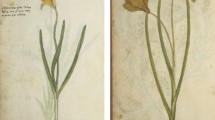Abstract
The taxonomy of the species ofCamellia L. involved in the evolution of the tea plant is discussed at length; a key and descriptions of species are given for ready identification. It is inferred that the cultivated tea populations are complex species hybrids and in view of this, Art. 29 of the “Cultivated Code” is applied to name the tea clones.
Similar content being viewed by others
References
Barua, P. K., Wilson’s Camellia.Camellian 7 18–20 (1956).
Barua, P. K., Classification of the tea plant.Two and A Bud 10 3–11 (1963).
Barua, P. K., Classification of the tea plant.Two and A Bud. 12 13–27 (1965).
Barua, P. K. and Dutta A. C., Leaf sclereids in the taxonomy ofThea Camellias. II.Camellia sinensis L.Phytomorphology 9 372–382 (1959).
Barua, P. K. and Wight, W., Leaf sclereids in the taxonomy ofThea Camellias—I. Wilson’s and relatedCamellias.Phytomorphology 8 257–264 (1958).
Bezbaruah, H. P. and Gogi, S. C., An interspecific hybrid between tea (Camellia sinensis L.) andC. japonica L.Proc. Indian Acad. Sci. 76 B 219–220 (1972).
Gilmour, J. S. L.et al. (editors),International Code of Nomenclature of Cultivated Plants, Utrecht, Netherlands (1969).
Kingdon-Ward, F., Does wild tea exist?Nature 165 297–299 (1950).
Lanjou, J.et al. (editors),International Code of Botanical Nomenclature, Utrecht, Netherlands (1966).
Masters, J. W., The Assam tea plant, compared with the tea plant of China.J. agric. hort. Soc. India 3 61–69 (1844).
Roberts, E. A. H., Wight, W. and Wood, D. J., Paper chromatography as an aid to the taxonomy ofThea Camellias.New Phytol. 57 211–225 (1958).
*Sealy, J. R.,Camellia taliensis. Curtis’ bot. Mag. 164 t. 9684 (1948).
Sealy, J. R.,A Revision of the Genus Camellia, London (1958).
Visser, T., Tea [Camellia sinensis (L.) O. Kuntze], in Ferwerda and Wit’s,Outlines of Perennial Crop Breeding in the Tropics, Wageningen, Netherlands pp. 459–493 (1969).
Watt, G.,The Commercial Products of India, pp. 209–244 (1908) (Repr. ed., 1966, New Delhi).
Wight, W., Commercial selection and breeding of tea in India.World Crops 8 263–268 (1956).
Wight, W., The agrotype concept in tea taxonomy.Nature 181 893–895 (1958).
Wight, W., Nomenclature and classification of the tea plant.Nature 183 1726–1728 (1959).
Wight, W., Tea classification revised.Curr. Sci. 31 298–299 (1962).
Wight, W., Tea seed and the tea industry of Assam.Int. Camellia J. 1 29–32 (1962).
Wight, W. and Barua, P. K., What is tea?Nature 179 506–507 (1957).
Wood, D. J. and Barua, P. K., Species hybrids of tea.Nature 181 1674–1675 (1958).
Author information
Authors and Affiliations
Rights and permissions
About this article
Cite this article
Sharma, V.S., Venkataramani, K.S. The tea complex. Proc. Indian Acad. Sci. 80, 178–187 (1974). https://doi.org/10.1007/BF03050722
Received:
Issue Date:
DOI: https://doi.org/10.1007/BF03050722




